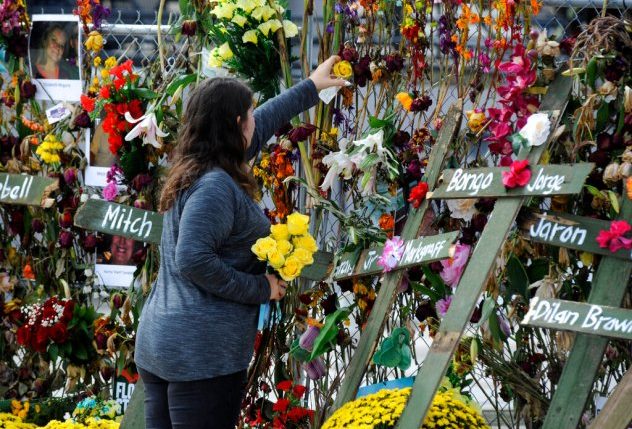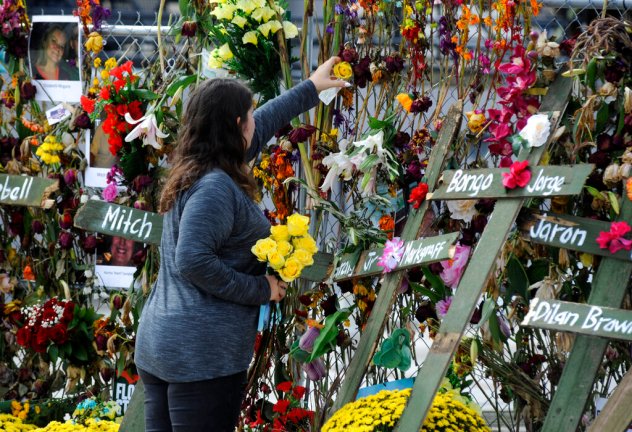
Calls To Mental Health Helpline 'skyrocket' In Wake Of Hurricane Ian

As Hurricane Ian carved through Florida, calls to one mental health helpline skyrocketed.
Collier County’s branch of the National Alliance on Mental Illness (NAMI) saw a sharp increase in calls to its “warmline” — a line usually dedicated to offering early intervention and emotional support to prevent a mental health crisis — during and since the devastating storm, Beth Hatch, CEO of the Collier County NAMI branch, told AccuWeather.
Even when the storm subsided, the calls to the crisis line continued pouring in.
The weight of Hurricane Ian’s emotional toll continues to ring out across the country as communities in the hard-hit areas of Florida slowly come to terms with the loss of loved ones, homes and futures that, for some, are now veiled in uncertainty.
“Everything in the house is a total loss…every square inch of the house [was] full of water,” Orlo Vista resident Damion Johnson told AccuWeather National Reporter Jillian Angeline. Located only a few miles west of Orlando, the community saw intense flooding as Ian cut across the state. In areas along Florida’s southwest coast, the emotional weight of Ian’s landfall continues to unfold.

“It’s horrible. As they say, it’s like a war zone,” Fort Myers Beach resident Alice Barrett told AccuWeather National Reporter Bill Wadell. “Everything that you used to know is gone.”
The medical examiner in Lee County, where Hurricane Ian first made landfall over Florida, said that two men in their 70s took their own lives after viewing their immense losses, according to The Associated Press.
Ian made landfall over Florida as a strong Category 4 hurricane, its powerful winds and storm surge wrecking causeways that connected communities to the mainland, tossing boats ashore like toys and sweeping entire homes off their foundations. The storm surge in Fort Myers Beach, one of the hardest hit locations, was found to have measured at least 15 feet , plus the rough surf and waves, authorities told Wadell.
The rising waters made it nearly impossible for Johnny Two Feathers, a resident of San Carlos Island located between Fort Myers Beach and Estero Island, to escape his own home as flood waters rose to his chest. The wind hurled boats around his home, one anchor taking off part of his roof and the bow of another boat smashing into his walls.
“I’m lucky,” Two Feathers told Wadell. “Like I said, this is the worst hurricane I’ve ever been in.”

As the number of fatalities continued to mount in the days following landfall, Ian was recognized as not only one of the strongest hurricanes to hit Florida in recent years but also one of the deadliest. With over 100 deaths confirmed and officials continuing to confirm fatalities, Ian is the deadliest hurricane on record to hit the state since the 1935 Labor Day Hurricane claimed around 400 lives.
Destroyed homes, businesses and vehicles presented additional financial burdens for families on top of the already traumatic experience.
“We know from studying a lot of storms in the past that about a third to even up to more than 50% of people will have a mental health impact after a disaster,” Dr. Jennifer Horney, head of epidemiology at the University of Delaware, told AccuWeather Prime Host Adam Del Rosso.
Symptoms of post-traumatic stress disorder (PTSD), anxiety, depression, insomnia and other kinds of mental health issues are normal following a hurricane, she added.
The state of Florida has a crisis hotline, and the federal government hosts a disaster distress helpline for people seeking crisis counseling following Ian. Hatch and her teams have also been going door to door to check on residents and deliver meals in some instances alongside NAMI’s community partners.
“What happens is that mental health is not the priority at first, by any means. It’s that survival state,” Hatch explained, adding that when basic needs aren’t met, it also has mental health side effects.

“As the recovery progresses, we expect people to be able to use their resources to be able to be resilient and bounce back, but a share of the people impacted won’t be able to do that,” Horney said. “And in part that’s because of a lack of access to adequate resources for crisis counseling.”
The years following disasters more often than not are characterized by navigating the bureaucracy of disaster recovery aid, deciding whether to rebuild or move entirely and focusing on reestablishing basic needs lost during the storm. Short-term crisis counseling is usually available starting 60 days after a disaster to a year, but then funding typically dries up.
With less accessible resources, mental health is often placed on the back burner.
In a study on suicide rates in U.S. counties that experienced a disaster between 2003 and 2015, Horney and her colleagues found suicide increased by 23% when comparing the three-year period before the event to the three years that followed.
Suicide rates jumped 26% within just the first year of recovery after hurricanes before returning to the baseline in the second year.
Ian’s long-term impact on mental health will vary even among neighboring communities due to the availability of resources, or lack thereof.
“We do see resilience in communities who come together to help one another out after a disaster, but that sort of myth of resilience, we also want to push back on that because everyone’s not equally able to avail themselves of the resources that are available,” Horney said. “So we really need to continue to focus on making sure that people have equitable access to what’s available to help them after a disaster.”

Community stigmas surrounding mental health treatment, transportation, language, and finances are a few barriers that may prevent someone from accessing long-term mental health care in addition to mental health facilities not having enough staff to keep up with the demand.
These hurdles in access to mental health following a hurricane often disproportionately impact people from marginalized communities, and Rob Todaro, senior communications manager for The Trevor Project, told AccuWeather that this includes LGBTQIA+ youth.
“We must acknowledge that the climate crisis will continue to disproportionately burden and displace the most marginalized communities, including LGBTQ young people who already face higher rates of homelessness and food insecurity, along with experiences of discrimination and barriers to mental health care,” Todaro said. “It’s crucial that we address the negative mental health impacts of the climate crisis, and connect our young people with the support services and care they need to navigate this increasingly uncertain world.”
Research over the years has strongly indicated that climate change is contributing to more damaging storms, with rising sea levels likely causing higher coastal inundation levels. Also, tropical rainfall rates, the intensity of storms and the proportion of storms that reach Category 4 and 5 strength are projected to increase due to a warming atmosphere, according to current research.

This is not a possibility for the distant future, but rather something scientists have already observed. In fact, a study from 2021 found that at least $8.1 billion of Superstorm Sandy’s damages in 2012 were attributed to climate-mediated anthropogenic sea level rise and resulted in an additional 71,000 people impacted by flooding.
In the article “Forecast: Increasing Mental Health Consequences From Atlantic Hurricanes Throughout the 21st Century,” researchers argued that as climate change contributes to more damaging storms, health care systems may expect to see more mental illness related to hurricanes.
“The complex effect of climate change on the behavior of hurricanes carries implications for the mental health and well-being of storm-affected populations,” according to the article.
Another reason people might not be able to fully address mental health problems following a disaster, Horney said, is “because we see so many more and so much more severe disasters these days that people don’t adequately have enough time to recover before they are under threat for another disaster.”
As Ian trekked toward Florida, the cone of uncertainty shifted to include Mexico Beach, Florida, which still bears the marks of Hurricane Michael’s landfall as a Category 5 storm. Even four years after that storm, local restaurant owner Michael Scoggins told storm chaser Brandon Clement that the city still wasn’t completely back on its feet. He cited the hotels in town that still hadn’t reopened, making it more difficult for visitors to stay in town.
Both Horney and the plethora of studies that research mental health following natural disasters recommended the involvement of psychiatrists in hurricane recovery and more funding for equitable access to mental health support following a disaster.
Additional reporting by AccuWeather National Reporters Jillian Angeline, Kim Leoffler, Bill Wadell and AccuWeather Prime Host Adam Del Rosso.
Produced in association with AccuWeather.
The Western Journal has not reviewed this story prior to publication. Therefore, it may not meet our normal editorial standards. It is provided to our readers as a service from The Western Journal.
Truth and Accuracy
We are committed to truth and accuracy in all of our journalism. Read our editorial standards.
Advertise with The Western Journal and reach millions of highly engaged readers, while supporting our work. Advertise Today.










